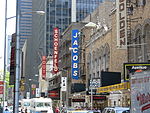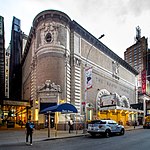Music Box Theatre

The Music Box Theatre is a Broadway theater at 239 West 45th Street (George Abbott Way) in the Theater District of Midtown Manhattan in New York City. Opened in 1921, the Music Box Theatre was designed by C. Howard Crane in a Palladian-inspired style and was constructed for Irving Berlin and Sam H. Harris. It has 1,025 seats across two levels and is operated by The Shubert Organization. Both the facade and the auditorium interior are New York City landmarks. The facade is made of limestone and is symmetrically arranged, with both Palladian and neo-Georgian motifs. At ground level, the eastern portion of the facade contains the theater's entrance, with a marquee over it, while the stage door is to the west. A double-height central colonnade at the second and third floors conceals a fire-escape staircase; it is flanked by windows in the outer bays. The auditorium contains Adam style detailing, a large balcony, and two outwardly curved box seats within ornate archways. The theater was also designed with a comparatively small lobby, a lounge in the basement, and mezzanine-level offices. Harris proposed the Music Box Theatre in 1919 specifically to host his productions with Berlin, and the Shubert family gained an ownership stake shortly after the Music Box opened. The theater initially hosted the partners' Music Box Revue nearly exclusively, presenting its first play, Cradle Snatchers, in 1925. Many of the Music Box's early productions were hits with several hundred performances. There were multiple productions by Moss Hart and George S. Kaufman in the 1930s, including Once in a Lifetime and The Man Who Came to Dinner. After Harris died in 1941, Berlin and the Shuberts shared ownership of the theater, and the Music Box largely showed dramas rather than musicals. The theater hosted several plays by William Inge in the 1950s. Though the length of production runs declined in later years, the Music Box has remained in theatrical use since its opening. The Shuberts acquired the Berlin estate's ownership stake in 2007.
Excerpt from the Wikipedia article Music Box Theatre (License: CC BY-SA 3.0, Authors, Images).Music Box Theatre
West 45th Street, New York Manhattan
Geographical coordinates (GPS) Address External links Nearby Places Show on map
Geographical coordinates (GPS)
| Latitude | Longitude |
|---|---|
| N 40.758864 ° | E -73.987178 ° |
Address
Music Box Theatre
West 45th Street 239
10036 New York, Manhattan
New York, United States
Open on Google Maps











